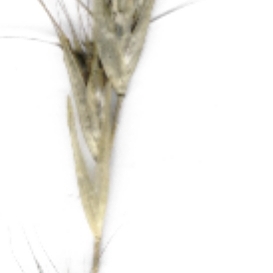Rather coarse, stiff, dense tufts, shortly rhizomatous; leaves « culms; branching intravaginal. Leaf-sheath pale, to light grey, glabrous or with scattered to dense hairs; apical tuft of hairs stiff, thick, to 2.5-(3.5) mm. Ligule 0.1-0.2 mm. Leaf-blade to 17 cm, rather harsh, grey-green, flat to inrolled, long stiff scattered hairs, margins closely scabrid. Culm stout, to 85 cm, internodes glabrous but minutely hairy below inflorescence. Panicle ± compact and broad to somewhat laxer, to 6 cm, of few large spikelets on short pedicels; rachis and pedicels rather sparsely, stiffly scabrid, with longer hair below spikelets and near branch axils. Spikelets 5-8-flowered, awns much exserted from glumes. Glumes pale, sometimes faintly purplish, lanceolate, subacute, ± equal, 8.5-12 mm, both 5-7-nerved, occasionally a few scattered hairs. Lemma (2)-3-4 mm, 9-nerved, upper row of hairs ≈ lemma, in a few isolated tufts, usually (0)-2-4 central tufts and 1-(2) denser marginal tufts, lower row dense and continuous, lower marginal tufts reaching or overlapping upper marginal tufts, elsewhere glabrous; lobes 7-10 mm, tapering to fine awns; central awn 12.5-15 mm, column 3-5 mm. Palea 2.5-3.7 mm, = upper marginal tufts, ≥ awn sinus, interkeel glabrous, margins glabrous or with a few long fine hairs. Callus 0.8-1 mm, thick marginal hair tufts overlapping lower lemma hairs. Rachilla 0.2-0.3 mm. Anthers c. 0.4 and 0.8-1.7 mm. Caryopsis 1.2-2 × 0.7-1 mm; embryo 0.5-0.9 mm; hilum 0.4-0.5 mm.
More
Plants caespitose; innovation buds intravaginal. Culms 14–70 cm high. Inflorescences obliquely ovate to linear-lanceolate, when linear the spikelets diverge from axis. Spikelets 10–22 mm long, with 5–8 florets. Glumes equalling to exceeding florets; lower glume 10.4–18.5 mm long, c. 3.5 mm wide. Lemma: body 2.8–4 mm long, glabrous to villous between the rows of tufts; upper row of hair tufts of marginal and some dorsal tufts or of only marginal tufts; lower row of tufts complete and not reaching the upper row; lobes as long as body; setae 3.5–7.5 mm long, as long as to longer than lobes; awn 11–18 mm long, exceeding setae; awn column tightly twisted, exceeding lobes but shorter than setae. Palea 3.2–4.4 mm long, narrow, 3–5 times as long as wide, reaching to slightly exceeding lemma sinus. Anthers 0.4–1.1 mm long. Caryopsis 1.6–1.8 mm long.

